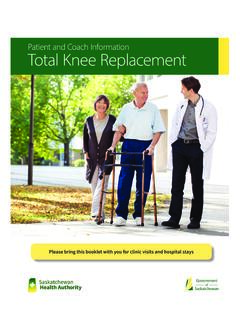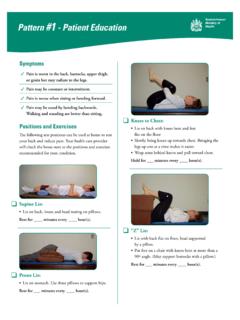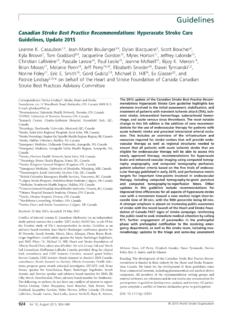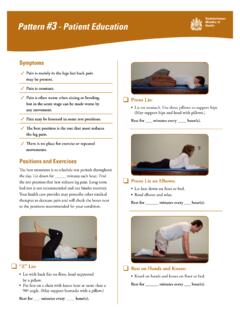Transcription of Knee Replacement Post-Op Exercise Booklet
1 knee REPLACEMENTPOST-OP Exercise BOOKThis Booklet belongs to:YOU MUST BRING THIS BOOK WITH YOU TO ALL your THERAPY APPOINTMENTS IN THE HOSPITAL AND TO ALL your OUTPATIENT APPOINTMENTSYou have an appointment to see your surgeon/physiotherapist at the Surgical Assessment Center on:If you need to change this appointment, please call 306-766-0401 Licence Plate number2 This Booklet will guide you in your physiotherapy journey from after your surgery to your first follow up appointment with your surgeon and outpatient physiotherapy you have any questions or concerns after discharge please call 766-0432 You will be receiving a phone call from the Surgical Assessment Center 48-72 hours after you are discharged from hospital to check on your part of your recovery, you are expected to complete your prescribed exercises twice a day, practice walking and apply ice as needed to your surgical area.
2 Use this chart to keep track of your ExercisesIce /ElevationAfternoon ExercisesIce / ElevationWalking As ToleratedAverage Pain Today 0-10 knee ROM ON DISCHARGE _____(To be filled out by your physiotherapist in hospital)4 Immediate post Op ExercisesCirculation Exercises Pump your feet up and down. Do this 10 times every hour that you are awake while in hospitalAnkle circles Do ankle exercises in each direction Do this 10 times every hour that you are awake while in hospital5 Breathing Exercises Sit or lie down. Inhale deeply through your nose. Without exhaling, take 3 small sniffs to fill your lungs. Hold 2 to 5 seconds, then exhale. Do this 10 times every hour that you are awake while in Squeezes With your legs straight out in front of you, squeeze the muscles on the front of your thighs and buttock muscles.
3 Hold for 3 seconds. Relax. Repeat 10 times, 3-4 times per your PainThere are several things that contribute to pain and management. Up to now, you have been experiencing arthritic pain , which is often described as a dull aching pain. This pain should cease with surgery. post operatively, you will be experiencing pain for a different reason this is surgical pain . This will improve with to Reduce Pain and SwellingIce and Heat Apply ice for 10-15 minutes to the operated knee , especially after Exercise . You can use ice as needed every 1-2 hours. Do not apply heat to your incision area. Talk to your physiotherapist before using any Medication Pain medication should be taken as prescribed in hospital.
4 It is important that your pain is controlled so that you can complete your 2 Exercise sessions every day. Take your pain medication 30-45 minutes before your Exercise Control You can help control/reduce the swelling in your knee by elevating the leg above the level of your heart, for 20 minutes, 2-3 times per day. Elevate your entire leg by placing pillows underneath the entire operated leg, not just under the Soon after surgery you will begin to walk short distances in your room. It is important to know your weight bearing status when you begin to walk. This means how much pressure you can put on your operated MUST CONTINUE USING your WALKER OR CRUTCHES FOR SIX WEEKS AFTER SURGERY your surgeon or physiotherapist will instruct you when to start using a Bearing As Tolerated: Stand up straight as you can.
5 You are allowed to put as much weight as you feel comfortable with on your operated Weight Bearing: You are allowed to put a maximum of 50% of your body weight through the operated much should I be standing/walking? Start with walking short distances in the hospital. Once discharged, gradually increase your walking in your house, within your tolerance. Prolonged standing can also increase your pain. An increase in knee pain and swelling, or an increase in night pain mayindicate you have been doing too to Stand When rising from a seated position you must place the foot of your operated leg ahead of the other foot. Put most of the weight through your arms and non-operated leg as you push up into a standing position.
6 Walking with your walker: Sequence: 1. Walker 2. Operated Leg 3. Non-operated leg Keep your head up. Advance the walker about an arm s length away. Step halfway into the walker with your operated leg, followed by your non-operated leg. Stand up tall and straight. Wear good supportive footwear with non-slip soles whenever Up 1. Hold the handrail with one hand and a cane or crutch in the other. 2. Step your non-operated leg up first. Then bring your operated leg and the cane or crutch up onto the step. Going Down 1. Hold the handrail with one hand and a cane or crutch in the other. 2. Step down with your operated leg, along with your cane or crutch. Then step down with your non- operated knee is Getting More Stiff and Sore!
7 What do I do??** If you experience the following once discharged home, see your family doctor or walk-in clinic ASAP** Increasing redness and/or increased temperature around your knee Increased incision drainage Generally feeling unwell Use the diagrams on the following pages to help track how much your knee is bending and straightening. If you are experiencing an increase in knee stiffness and no increase in range of motion are you doing the following: Doing enough exercises? If your knee is becoming stiffer you should increase the frequency of exercises you are doing. It is necessary to hold the stretch for 20-30 seconds at the end of your range of motion. It is normal to have pain while doing the exercises.
8 Taking your pain medication as prescribed in the hospital? Icing your knee frequently? You should ice your knee for 10-15 minutes, especially after the exercises. You can ice every 1-2 hours. Elevating your leg above the heart level? Ensure you are laying down with your entire operated leg elevated for 20 minutes, 2-3 times per day. Doing too much other activity? Often a sudden increase in activity is the reason for an increase in knee swelling and stiffness. Take more rest breaks. Staying in one position? Be sure to change positions regularly as staying in one position for too long can increase your your knee BendSitting in a chair with your body weight evenly distributed on both buttocks and your back against the chair, bend your operated knee by sliding your heel under the seat.
9 Use the diagram below to estimate how much your knee is bending. your goal is to be to at least position 3 or further by two weeks after your you are having difficulty achieving position 2, consider doing more of your knee bending exercises on pages 14 and Designed By MMS-JP-201413 Estimate your knee StraighteningLying on your back, attempt to straighten your knee as much as possible. Use the diagrams below to estimate how straight your knee is. your goal is to achieve position B in 4-6 weeks after your surgery. If you are having difficulty achieving position B, consider doing more of your knee straightening Exercise on page 15 and the knee stretch on page Designed By MMS-JP-2014 Designed By MMS-JP-201414 post Op knee Exercises You will begin these exercises while in hospital and will continue to do them at home once discharged.
10 Do only the checked exercisesq Seated knee Straightening/Bending1. Sit in a chair or on your bed with good posture. 2. Pull the toes up and straighten your knee . 3. Hold for a count of five then slowly lower your foot and bend your knee as far back as you can. 4. Alternate with the other leg. 5. Start with 10 repetitions. Gradually progress to 30 repetitions on each leg, 2 times per knee Squeezes1. Lie on your back with your legs straight. You can place a small roll under your knees. 2. Pull your toes up, push the backs of your knees down tightening your thigh muscles. Gently squeeze your buttock muscles as Hold for a count of 5, then relax. 4. Start with 10 repetitions. Gradually progress to 30 repetitions, 2 times per knee Bending1.










